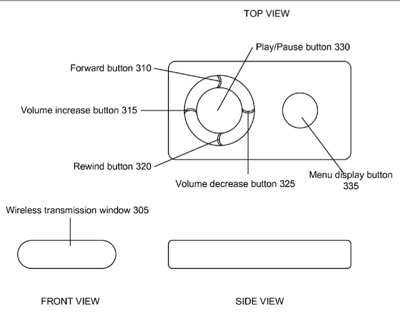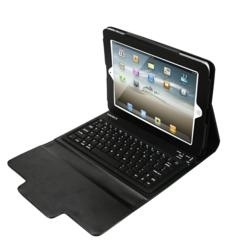An Apple patent (number 20120207444) for transport control of a media device has appeared at the U.S. Patent & Trademark Office. It involves manipulating a media processing device to control the presentation of content.
The patent is for a method of scanning content comprises receiving an input signal indicating that content being displayed is to be scanned, sensing a duration of the received input signal, and scanning the content at a rate based at least in part on the sensed duration of the received input.
Here’s Apple’s background and summary of the invention: “Media processing devices embedded with media applications capable of playing audio and visual content enhance user experience. The content can include music, video, photographs, and the like. Such media processing devices can be configured to play either a single type of content. For example, certain DVD players can play back only video content stored on a DVD. Other devices can be configured to play a plurality of content including audio, video, images, and the like. For example, the iPod, manufactured by Apple Computers of Cupertino, Calif., can play audio and video content.
“The content played on media processing devices can be manipulated based on user input. For example, in media processing devices capable of playing a plurality of content types, users can choose to play audio content, stop the audio content, and switch to video content. While playing video content, users can manipulate the presentation state of the content. The presentation state can include play, stop, pause, forward, rewind, and the like.
“Often, media processing devices are configured to present users with an interface through which users can provide input to manipulate the content. Users can interact with the interface through devices including either wired and wireless remote control devices.
“The present inventors recognized that the ability to control a media processing device to manipulate the state of content presented on a display device using as few interactions with a remote control device as necessary is desirable to users.
“In one aspect, a method of scanning content is described. The method can include receiving an input signal indicating that content being played is to be scanned, sensing a duration of the received input signal, and scanning the content at a rate based at least in part on the sensed duration of the received input.
“This and other aspects can include one or more of the following features. The scanning can include moving a playhead position in an accelerated manner from a current location in the content to a different location in the content. The content can include digital media content. The input can be received by pressing a button on a remote control device and the duration of the input can correspond to a duration for which a button on the remote control device is pressed.
“The content can be played at a play frame rate and the play frame rate can be increased to a first frame rate when the duration of the input exceeds a first threshold. The play frame rate can be increased to a second frame rate when the duration of the input exceeds a second threshold, wherein the second frame rate is greater than the first frame rate and the second threshold is greater than the second threshold. The method can further include sensing a cessation of input signal, wherein the rate is returned to the play frame rate upon sensing the cessation.
“The input signal can be provided by clicking a button on the remote control device. The content can be divided into a plurality of segments, wherein each segment can include one or more frames, and a number of frames in each segment can depend on a time length of the content. Each segment can be referenced by a frame in the segment. Upon sensing the clicking, a playhead corresponding to a location of a frame in a segment being displayed can be moved to a first frame of a subsequent segment. The content can be scanned either in a forward or a backward direction.
‘In another aspect, a system for scanning content is described. The system can be configured to receive an input signal indicating that content being played is to be scanned, sense a duration of the received input signal, and scan the content at a rate based at least in part on the sensed duration of the received input.
‘This and other aspects can include one or more of the following features. The system can be configured to scan the content can be further configured to move a playhead position in an accelerated manner from a current location in the content to a different location in the content. The content can include digital media content. The system can be further configured to receive input by pressing a button on a remote control device, the duration of the input corresponding to a duration for which a button on the remote control device is pressed.
‘The system can be further configured to play the content at a play frame rate, and increase the play frame rate to a first frame rate when the duration of the input exceeds a first threshold. The system can be further configured to increase the play frame rate to a second frame rate when the duration of the input exceeds a second threshold, wherein the second frame rate is greater than the first frame rate and the second threshold is greater than the first threshold.
“The system can be further configured to sense a cessation of input signal, wherein the rate is returned to the play frame rate upon sensing the cessation. The input signal can be provided by clicking a button on the remote control device. The system can be further configured to divide the content into a plurality of segments, wherein each segment can include one or more frames, and a number of frames in each segment can depend on a time length of the content.
‘Each segment can be referenced by a frame in the segment. The system can be further configured to move a playhead corresponding to a location of a frame in a segment being displayed to a first frame of a subsequent segment, upon sensing the clicking. The system can be further configured to scan the content in either a forward or a backward direction.
“In one example, the system and techniques described here can present content on a display device, manipulate the state of the content on the display device in response to user input, wherein the user input can be received from a wireless remote control device. The system and techniques described here may present one or more of the following advantages.
“First, using a wireless remote control device allows users to control the media processing device without being physically present adjacent to the media processing device. Moreover, using the same wireless remote control device, users can perform multiple operations on the content including play, stop, pause, forward, rewind, and the like. Further, during forward and rewind operations, users can alter the rate at which content is scanned using the remote control device to reach desired viewing points faster. Still further, during pause operations, users can step through content to enhance the viewing experience.”
The inventors are Rainer Brodersen, Jeffrey Robbin, Thomas Michael Madden, Clare Rachel Goldeen and Jeffrey Ma.



